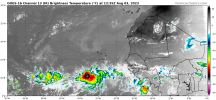Casuarina Head
Member
@JPWX You mentioned your dream(s) and its portentous implication(s). Well, since we are talking about esoteric factors, here are mine. I was born and once resided in South Florida and have experienced a few coincidences of my own:
My memory is very impressionistic, so I could be wrong about this, but I distinctly recall “dreaming” many years ago about a Category-5 hurricane impacting my old hometown, which was just north of Fort Lauderdale, miles inland from the coast. In the “dream” the eye passed overhead and tremendous damage was observed after the “storm.” Based on various details this storm was probably on the order of 155+ knots (180+ mph) at landfall and continued across South Florida, eventually entering the Gulf of Mexico. In the “dream” I never actually “saw” the second landfall, but for some reason I “feel” as though the “storm” made a second Cat-4+ impact on either New Orleans or Houston/Galveston, most probably the latter.
The “dream” occurred at latest in the second half of the 1990s or in the very early 2000s, but almost certainly at least some years prior to 2003, when, to my recollection, I first began investigating meteorology online. I actually do not know whether I dreamed of this or collated details from various experiences and/or interests, but I’ve decided to mention it. I don’t know whether my “dream” holds any validity, for it occurred some decades ago, and the “scenario” that it outlined has not transpired...yet. But then again, one of your dreams took about a decade to verify...
Personally, I suspect that the lack of high-end, Category-4+ hits on Greater Miami since 1992, and especially since 2016, might hint that the next such impact, if and when it arrives, may be absolutely historic, in terms of size, intensity, and/or impact. The exact date obviously cannot be determined, and I could be wrong here (I have incorrectly anticipated just such an impact in several previous seasons and have been proven wrong), but it is worth pondering, perhaps. In light of your own portents, could 2023 feature a storm that combines features of mine and yours? Who knows?
- I was born exactly twenty-four hours after Hurricane Andrew (1992) made landfall near Homestead, down to the very minute
- On my thirteenth birthday, Hurricane Katrina made landfall on South Florida, and later on Wilma’s eye passed over my home
My memory is very impressionistic, so I could be wrong about this, but I distinctly recall “dreaming” many years ago about a Category-5 hurricane impacting my old hometown, which was just north of Fort Lauderdale, miles inland from the coast. In the “dream” the eye passed overhead and tremendous damage was observed after the “storm.” Based on various details this storm was probably on the order of 155+ knots (180+ mph) at landfall and continued across South Florida, eventually entering the Gulf of Mexico. In the “dream” I never actually “saw” the second landfall, but for some reason I “feel” as though the “storm” made a second Cat-4+ impact on either New Orleans or Houston/Galveston, most probably the latter.
The “dream” occurred at latest in the second half of the 1990s or in the very early 2000s, but almost certainly at least some years prior to 2003, when, to my recollection, I first began investigating meteorology online. I actually do not know whether I dreamed of this or collated details from various experiences and/or interests, but I’ve decided to mention it. I don’t know whether my “dream” holds any validity, for it occurred some decades ago, and the “scenario” that it outlined has not transpired...yet. But then again, one of your dreams took about a decade to verify...
Personally, I suspect that the lack of high-end, Category-4+ hits on Greater Miami since 1992, and especially since 2016, might hint that the next such impact, if and when it arrives, may be absolutely historic, in terms of size, intensity, and/or impact. The exact date obviously cannot be determined, and I could be wrong here (I have incorrectly anticipated just such an impact in several previous seasons and have been proven wrong), but it is worth pondering, perhaps. In light of your own portents, could 2023 feature a storm that combines features of mine and yours? Who knows?
Last edited:











